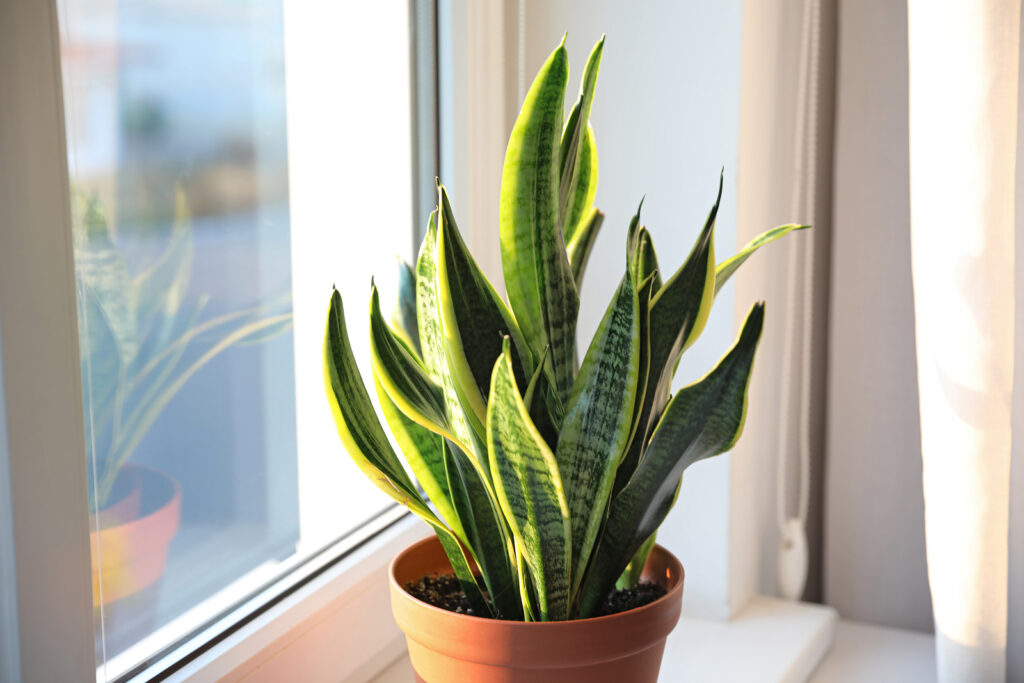Sansevieria–sometimes called snake plant–has stiff-leaf swords that are deep green crossbanded in dark green, yellow, white, or black. Sansevieria grows best in bright light but will adapt to almost any level of light.
Sansevieria is a genus of perennials with stiff, very thick green leaves, often mottled with white, and clustered flowers on slender stalks. Plants may be either erect, measuring up to 30 inches (76 cm) tall, or in low-lying rosettes, measuring to 3 inches (8 cm) across. Flowers are rare, appearing as whitish-yellow clusters.
In northern regions, Sansevieria is grown as a house or porch plant requiring little sun and doing beds in rather heavy soil. They can be grown in the garden in warm southern regions.
When grown indoors Sansevieria leaves should be washed frequently with warm soapy water and then sponged off with clear water.
Sansevieria propagation is by division or by leaf-cuttings set in sand which send out shoots that root and develop into new plants.
Sansevieria is a genus of about 60 species.
Get to know Sansevieria
- Plant type: Tropical evergreen perennial
- Growing Zones and range: 10-11
- Hardiness: Tender
- Optimal growing temperature: day, 65° to 80°F (18° to 27°C); night, 60° to 65°F (16° to 18°C).
- Light: Bright light with some direct sun, but will grow in low light
- Height and width: Grows to 4 feet (1.2m) tall and 20 inches (7.8cm) wide depending on type and age
- Foliage: Tall, succulent, pointed foliage with white, yellow, or silver crossbanding and white or yellow edges
- Flowers: Sprays of green-white, fragrant flowers.
- Uses: Houseplant
- Common name: Snake plant, mother-in-law’s tongue
- Botanical name: Sansevieria trifasciata
- Family: Agavaceae
- Origin: Dry habitats of tropical Africa, Madagascar, India, and Indonesia
Where to plant Sansevieria
- Grow Sansevieria in bright light; plants can tolerate almost any level of light.
- Indoors grow Sansevieria in bright light, with direct sun daily, from eastern or western exposure. Does well under artificial light, needing 14 to 16 light-hours daily.
- Grow Sansevieria in cactus or all-purpose mix in a well-drained pot.

How to water and feed Sansevieria
- Sansevieria needs evenly moist water; allow the soil to dry out somewhat between waterings. In winter, water only once a month or so. Let soil dry between thorough waterings. Overwatering can result in rot or death of the plant.
- Sansevieria prefers humidity of 25% to 30%.
- Feed Sansevieria monthly, with mild liquid fertilizer.
Sansevieria care
- Sansevieria prefers to be potbound; pot-on when roots occupy over ¾ of pot space.
- Remove dead leaves; clean the foliage monthly.
- If tall leaves start to flop, tie them together with soft, thick string or twine that won’t rub leaves.
- Be careful when handling Sansevieria; if a leaf tip is broken off, the leaf will stop growing.
- Cold temperatures can cause leaf edges of turn brown; move the plant to a warmer spot to prevent further damage.
- Rot can develop if water is allowed to collect in rosettes.
- Sansevieria rests slightly during winter. Let the soil dry and not completely between waterings; withhold fertilizer.
Growing Sansevieria as a houseplant
- Sansevieria grows best in bright to direct light, an average to warm temperature and medium humidity.
- Sansevieria can adapt to a wide range of conditions, but limited light and low humidity can slow its growth.
- The soil should be allowed to dry between waterings; overwatering can foster root rot.
- It should e fertilized every other month during spring and summer.
Sansevieria propagation
- Propagate Sanseivieria by leaf cuttings, offsets, or rhizome division.
- Divide Sansevieria at any time or separate and pot up offsets.
- Propagate green-leaved types by leaf cuttings. Remove a leaf, slice it crosswise into 3-inch sections, and insert the bottom side of each section into moist sand.
Sansevieria varieties to grow
- Sansevieria cylindrica can reach 5 feet tall.
- S. ehrenbergii. Grows upright to 6 feet (1.8 m), with flat-margined leaves fanning out from a basal center stem; leaves are blue-green with white edges.
- S. trifasciata, snake plant, mother-in-law’s tongue. Stiffly erect, 4-foot leaves are dark green, broadly banded with silvery gray.
- S. trifasciata ‘Hahnii’, bird’s nest sansevieria. Dwarf form with a 6 inch (15 cm) tall funnel-shaped leaf rosette featuring light and dark green patterning.
- S. trifasciata ‘Laurentii’. Grows 1 to 3 feet tall. ‘Hahnii’ a bit taller with a spreading habit.
- S. zeylanica (bowstring hemp). Loose rosette of 30-inch (76 cm) leaves, which arch away from the base; leaves are gray-green with darker vertical bands.



